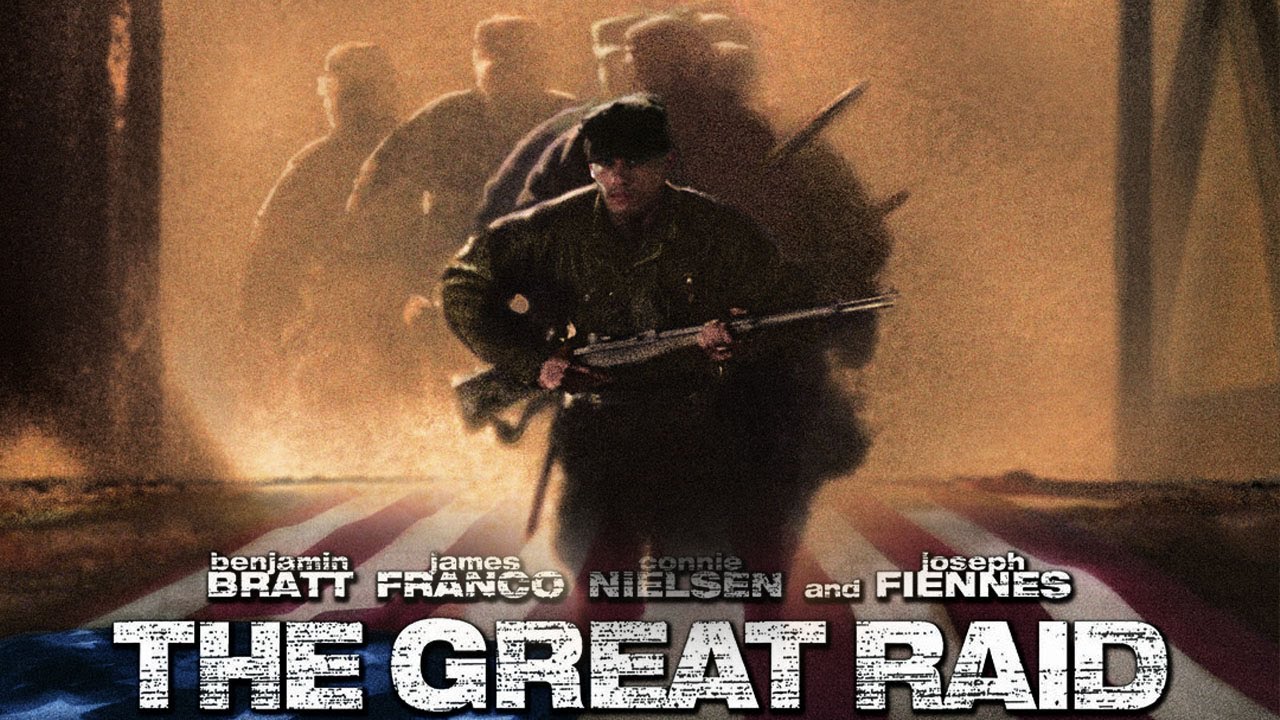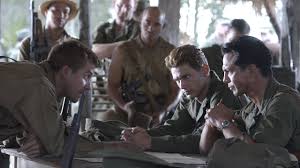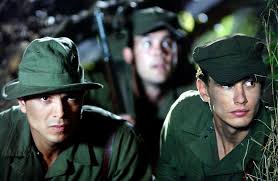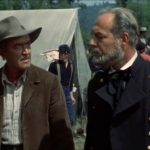🎬 The Great Raid (2005)

The Great Raid (2005) Movie Review: A Riveting World War II Drama of Bravery and Sacrifice
Introduction: A Heroic Tale of War and Survival
“The Great Raid” (2005), directed by John Dahl, is a powerful war drama based on the true story of the daring rescue mission to free American prisoners of war (POWs) held by the Japanese during World War II. Set in the Philippines in 1945, the film chronicles the courage and determination of a group of American soldiers who embark on a dangerous mission to rescue over 500 POWs from the infamous Cabanatuan prison camp. The film stars Benjamin Bratt, James Franco, and Connie Nielsen, offering a gripping portrayal of bravery, sacrifice, and the unbreakable human spirit in the face of wartime adversity.
With its focus on a lesser-known but incredible historical event, The Great Raid shines a light on the heroic efforts of the soldiers involved, highlighting the risks they took and the lives they saved in the closing days of the war in the Pacific. The film’s combination of action, emotion, and historical authenticity makes it an unforgettable portrayal of courage and heroism.
Plot Summary: A Daring Rescue Mission
The story of The Great Raid is set during the final stages of World War II in 1945. The United States has been making significant progress against Japan in the Pacific Theater, but many American soldiers remain imprisoned in Japanese POW camps. Among the most notorious of these camps is Cabanatuan, where over 500 American POWs are being held under harsh conditions.
The plot centers on the mission to rescue these prisoners, a task that is taken on by a small group of elite soldiers from the 6th Ranger Battalion, led by Lieutenant Colonel Henry Mucci (Benjamin Bratt). The Rangers are tasked with infiltrating Japanese-occupied territory, traveling over 30 miles through enemy lines, and liberating the POWs before the Japanese can execute them or move them to a more secure location.
The mission is fraught with danger, as the Rangers must face not only the challenges of navigating through hostile terrain but also the threat of Japanese patrols and the brutality of the enemy. The film effectively captures the tension of the operation, combining action-packed sequences with moments of quiet, introspective character development.
The Cabanatuan prison camp, where the majority of the film’s action takes place, serves as the focal point for the emotional weight of the story. The camp’s conditions are dire, with the POWs suffering from malnutrition, disease, and the ever-present fear of death. The rescue mission becomes a race against time, as the Rangers must reach the camp and free the prisoners before the Japanese authorities can carry out their brutal plans.
The Performances: Strong, Emotionally-Resonant Portrayals of Courage
The performances in The Great Raid are a key factor in the film’s emotional depth. Benjamin Bratt shines in his role as Lieutenant Colonel Henry Mucci, a man who must balance the weight of command with his desire to save the men under his care. Bratt’s portrayal of Mucci is both stoic and vulnerable, capturing the internal conflict that arises from the monumental responsibility of the mission. His leadership is tested not only by the physical danger of the mission but also by the emotional toll it takes on him and his men.
James Franco, known for his versatile acting career, plays Captain Robert Prince, Mucci’s second-in-command. Franco brings a sense of quiet intensity to the role, playing a character who is deeply committed to the mission but also haunted by the realities of war. His performance adds a layer of emotional complexity to the film, as he must wrestle with the choices that come with leading men into harm’s way.
Connie Nielsen plays Margaret Utinsky, a nurse who is caught in the midst of the war and forms a romantic interest with one of the soldiers. While her role is somewhat secondary to the primary focus of the rescue mission, Nielsen brings a sense of strength and resilience to her character, adding an important emotional thread to the film. Her relationship with the soldiers provides a personal touch to the broader military drama.
The supporting cast also delivers strong performances, with notable appearances from actors such as Craig S. Hall and Max Martini. Each actor contributes to the sense of camaraderie and brotherhood that runs through the heart of the film. The Rangers’ unity and commitment to the mission are essential to the emotional power of The Great Raid, and the cast’s performances make these themes resonate.
Cinematography and Visuals: A Visceral Depiction of War
The cinematography in The Great Raid effectively conveys the tension, danger, and emotional stakes of the mission. The film’s visual style combines gritty realism with moments of breathtaking beauty, helping to immerse the audience in the period and the intense conditions the soldiers and POWs endured.
The film’s action sequences are well-choreographed and intense, capturing the brutal nature of combat and the uncertainty of every decision. Whether it’s a firefight with Japanese soldiers or the quiet, perilous moments as the Rangers move through the jungle, the cinematography highlights the stakes of the mission. The camerawork is fluid, and the use of lighting and shadows effectively heightens the suspense, especially during the infiltration of the prison camp.
The film also makes use of wide shots to showcase the natural beauty of the Philippine landscape, contrasting the serenity of the environment with the violence and fear of war. These shots provide a stark reminder of the harsh conditions the soldiers faced and the fragility of life during wartime.
Historical Accuracy: Honoring a Heroic Moment in History
The Great Raid is based on the true events surrounding the rescue of American POWs from the Cabanatuan prison camp. The mission, which took place on January 30, 1945, was one of the most successful and daring rescue operations of World War II. The Rangers involved in the operation faced tremendous odds, and their success was due to a combination of meticulous planning, bravery, and luck.
The film stays relatively true to the historical events, portraying the strategy, challenges, and sacrifices made by the soldiers involved. The portrayal of the prison camp and the conditions the POWs endured is one of the most powerful aspects of the film, as it shows the dehumanizing effects of captivity and the toll it takes on both the prisoners and their rescuers.
The film also highlights the broader context of the war, including the brutal treatment of POWs by the Japanese and the strategic importance of the Philippines in the final stages of the war. While The Great Raid takes some creative liberties for dramatic effect, it remains faithful to the core elements of the mission, making it an important historical tribute to the courage of the Rangers and the men they rescued.
Themes: Brotherhood, Sacrifice, and the Cost of War
At its heart, The Great Raid is about the bonds formed between soldiers, the sacrifices they make for one another, and the price of war. The film emphasizes the sense of camaraderie that develops among the Rangers as they work together to achieve a common goal. This brotherhood is central to the film, as it underscores the emotional stakes of the mission. The soldiers’ willingness to risk their lives for each other creates a powerful sense of loyalty and honor, which is one of the film’s most moving aspects.
Another key theme is sacrifice. The Rangers are not just fighting for victory, but for the lives of the POWs. Many of them know the risks involved in the mission and are prepared to make the ultimate sacrifice to ensure the safety of their comrades. The film’s portrayal of sacrifice is poignant, as it shows the personal costs of war, both on the battlefield and at home.
The cost of war is also explored through the experiences of the POWs, who are subjected to inhumane conditions and the constant threat of death. Their struggle to survive, coupled with their hopes of rescue, forms an emotional foundation for the film. The contrast between the soldiers’ fight to free the prisoners and the prisoners’ fight for survival highlights the profound impact of war on individuals.
Conclusion: A Gripping, Heroic Tale of War and Survival
The Great Raid (2005) is a powerful, emotionally resonant war drama that captures the heroism and sacrifices made by soldiers during World War II. The film’s combination of intense action, historical accuracy, and emotional depth makes it a compelling portrayal of one of the most remarkable rescue missions in military history. With strong performances, captivating cinematography, and a poignant exploration of war’s human cost, The Great Raid is a must-see for fans of historical dramas and war films.
For those interested in stories of bravery, sacrifice, and the bonds of brotherhood forged in the heat of battle, The Great Raid offers a gripping and unforgettable cinematic experience. This film is not only a tribute to the soldiers who fought for freedom but also a powerful reminder of the strength of the human spirit in the face of unimaginable odds.










